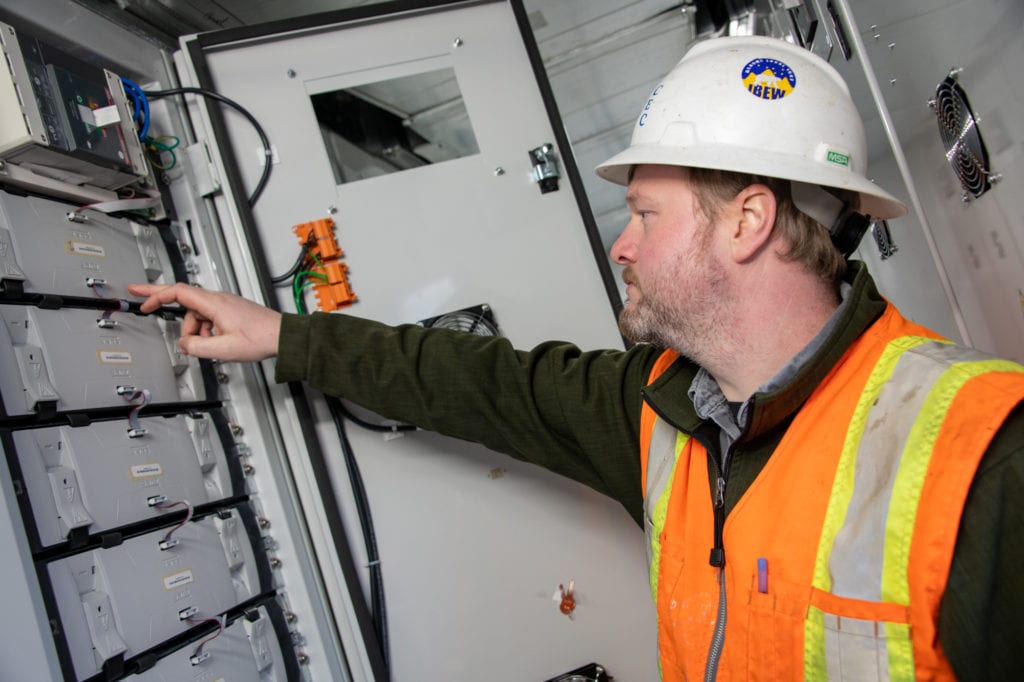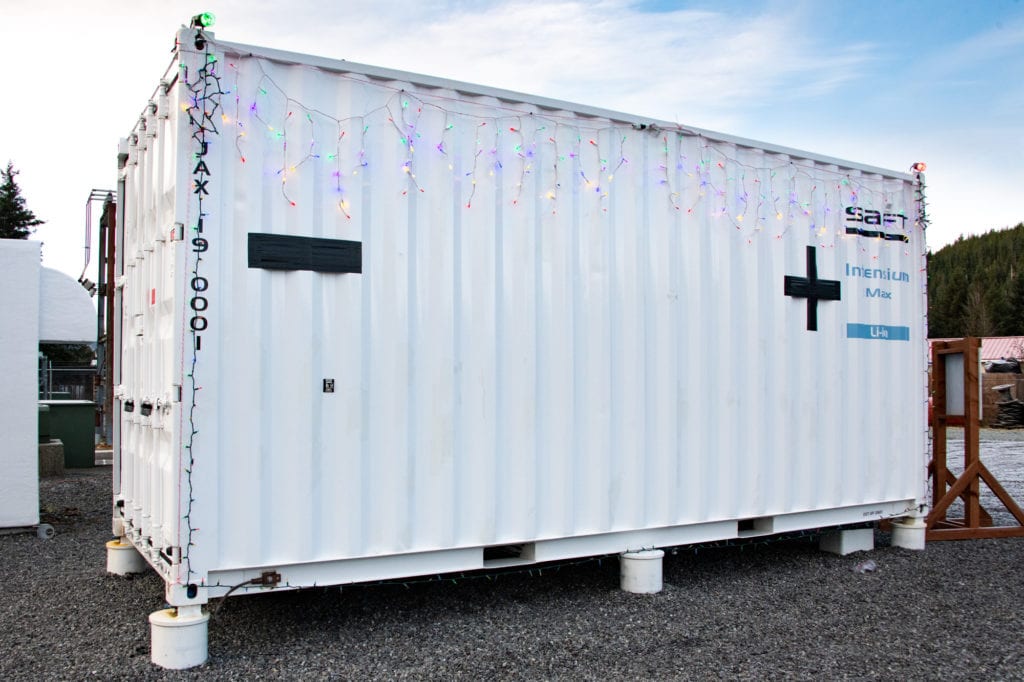
It doesn’t look like much: a white shipping container roughly large enough to hold a car. But, for the past two months, Cordova Electric Cooperative’s 850-volt battery has been quietly cutting power bills across town. CEC expects the system to save around $350,000 per year, says Production Foreman Nate Cain.
The battery doesn’t generate its own energy, but a newly designed automation system allows it to cut down on wasted power. In the course of a typical day, CEC unproductively burns thousands of dollars’ worth of diesel — not by carelessness, but because of a strange quirk of the power system.
Escaping the ‘valley of death’
When you switch on your living-room light — or power up your cannery — you expect electricity to flow immediately. This means that CEC always has to be prepared to generate a little more electricity than is already being used. There must be a surplus to draw on so that your light can illuminate as soon as the switch is pulled. Or, to look at it another way: if you’re having five friends over, it would be wise to have enough beer for eight or so people on hand, just in case an extra person or two shows up. If demand suddenly rises and you have nothing in reserve, you could run out abruptly.
When CEC’s system is running on hydroelectric power, some water must be directed away from the generator’s turbine. As demand for power rises, that extra water is released toward the turbine, generating more electricity. However, when demand for power rises toward the maximum of CEC’s hydroelectric capacity, hydroelectric power must be supplemented by starting a diesel generator. This generator isn’t producing useful power — it’s burning diesel simply to create a reserve that can be drawn upon as demand for power increases.
In these circumstances, the diesel generator is run at its minimum capacity, around 500 kilowatts. If that’s more power than is required to fill the reserve, then hydroelectric power must be lowered, diverting more water away from the turbine. This is what Clay Koplin, CEO of CEC and Cordova mayor, colorfully calls the “valley of death”: when substantial amounts of both water and diesel are being frittered away in order to maintain a power reserve of the proper size.
Returning to our beer analogy: say you’ve poured eight glasses of beer, and you and your five friends have settled into a conversation about the ferry outage, moose hunting and sundry other topics. Soon, you are joined by an extra guest. This makes seven people for eight glasses of beer. You’re fine for the moment, but what if two or three more people show up? You’ve poured all your beer, so, to be on the safe side, you uncork a bottle of wine large enough for four people. You now have enough drinks to serve 12 people, meaning you’ll be fine if up to four more people show up. However, if no one else arrives, by tomorrow morning you’ll end up with one glass of flat, warm beer and one bottle of stale wine. But wasting these drinks is the necessary cost of creating a buffer between the amount of alcohol needed now and the amount that could be needed if more thirsty guests arrive. This is, from a bartender’s point of view, the “valley of death.”
When CEC’s system enters the “valley of death” — outputting almost, but not quite, enough energy to max out its hydroelectric capacity — the waste is substantial. At worst, CEC’s diesel generator unproductively burns away $300 worth of fuel each hour.
Until now, CEC typically spent about 1,200 hours per year in the “valley of death.” This wasn’t a problem that could be solved by retraining, reorganizing, hiring more staff or buying a bigger generator. Anyone wishing to escape the “valley of death” would have to find a new path out.

‘Some pretty cutting-edge stuff’
CEC’s 850-volt, $2 million battery arrived in June, and lies tucked away behind chain-link fencing near Eyak Lake. Though it’s white as a tuxedo shirt, the battery has hardly had time to begin gathering scuffs and rust streaks. Production Foreman Nate Cain clearly takes a certain pride in the battery — as he opens its service door, he notes with dissatisfaction that someone has applied red grease around the doorframe, which stands out like lipstick stains on linen.
CEC’s white whale holds enough charge to run at 1,000 kilowatts for an hour, enough to keep Cordova Community Medical Center running for 10 hours. For the Christmas season, the battery has been strung with fairy lights and given large black “plus” and “minus” signs at either end.
Since June, CEC has experimented with designs for a scan and control system that would allow the battery to run automatically, substituting for the surplus of water- or diesel-fueled energy normally needed to maintain a reserve of extra power. For help engineering and testing the system, CEC called on ABB Group, Electric Power Systems, SAFT, Sandia National Laboratories and other leading industry groups. CEC is the first company in North America to use an automated battery as a substitute for a spending reserve, Cain said.
By the Thanksgiving holiday, CEC technicians were confident the automated system was, at least, stable enough not to cause blackouts. It first went online Nov. 27-28. During this period, CEC would typically burn about $12,600 worth of diesel. This Thanksgiving, with the automated battery running, diesel consumption was reduced to $2,500. After five months of trial and error, Cain had ample reason to give thanks.
“It’s not AI, but it’s as close as CEC and Cordova can do,” Cain said. “Getting my mind outside the box and understanding how the battery works was, for me, the most challenging thing. It took weeks of diving in deep and thinking about how it was going to work…We’re doing some pretty cutting-edge stuff here.”
Though the phrase “scan and control system” may be enough to make your eyes glaze over, CEC’s predictions about the savings the system will make should be enough to wake you back up. Once the automated battery is running full-time, a typical customer should save roughly $100 per year in bills and maintenance calls, Cain said. The new system should also allow the company to raise its usage of hydroelectricity from around 65-75 percent to upwards of 80 percent.
Year-round residents should benefit most from the system, as seasonal workers arrive in town when hydroelectric power is at its most plentiful and CEC spends less time stranded in the “valley of death,” Cain said.
Troubleshooting continues, with the system taken offline briefly on Dec. 5 to make tweaks to its software. However, the system should be up and running stably by New Year’s, Cain said.
“Now, everybody can put up Christmas lights this year,” said Brian Wagner, an operator at CEC’s Orca Generating Station.





